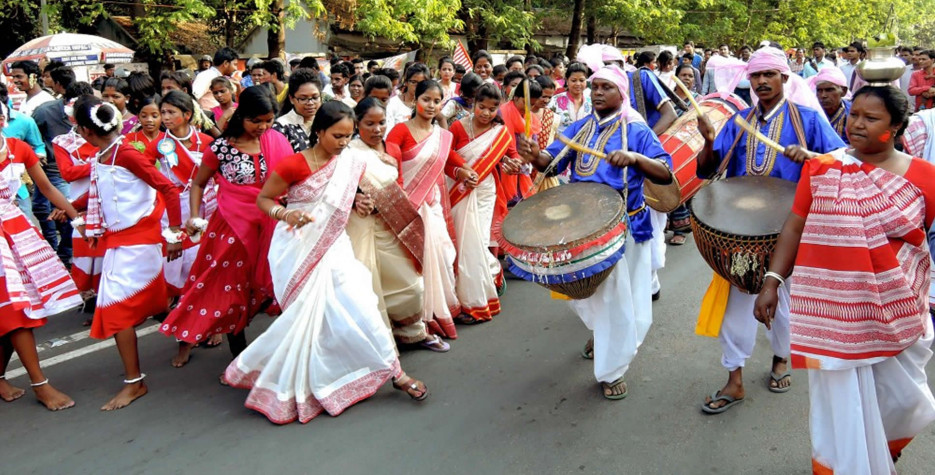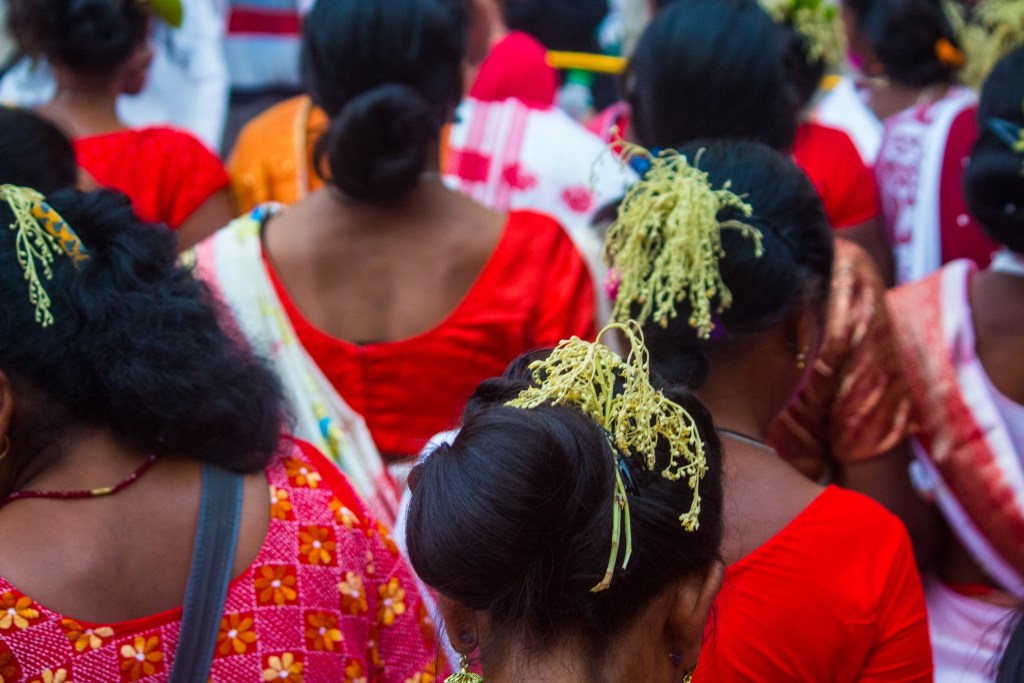In the heartland of India, amidst the lush greenery and rich cultural heritage of Jharkhand, there exists a festival that embodies the spirit of reverence for nature and the celebration of life – the Sarhul Festival. This vibrant and colourful festival is deeply rooted in the tribal traditions of the region and holds immense significance for the indigenous communities of Jharkhand. Sarhul is being celebrated today in Jharkhand.
Sarhul, which literally translates to ‘worship of trees’, is primarily a spring festival celebrated with great fervour and enthusiasm by the tribal people of Jharkhand. It usually falls during April, marking the onset of the spring season when nature is in full bloom, and the earth is adorned with vibrant hues of flowers and new leaves. The festival is a time for the tribal communities to express their gratitude to Mother Nature for her bountiful blessings and seek her continued benevolence for a prosperous future.

The word “Sarhul” is derived from the words “sar” meaning “seed” and “hul” meaning “to sow.” Central to the Sarhul Festival is the worship of the sacred Sal tree (Shorea robusta), which holds immense significance in tribal culture. The Sal tree is revered as a symbol of fertility, prosperity, and spiritual energy. During Sarhul, people gather around the sacred groves or under the shade of these magnificent trees to offer prayers, perform rituals, and seek blessings for the well-being of their families and communities.
The festivities of Sarhul are marked by a series of rituals and cultural performances that showcase the rich cultural heritage of Jharkhand’s tribal communities. One of the highlights of the festival is the ‘Sarhul Dance’, where men and women dressed in traditional attire come together to perform rhythmic dances accompanied by indigenous musical instruments like the dhols, flutes, and mandars. The dance is a joyful expression of gratitude towards nature and is often accompanied by songs praising the beauty of the natural world. On the day of the festival, people gather in their community halls or ‘akharas’ to offer prayers to their deities.

Another integral aspect of the Sarhul Festival is the exchange of traditional greetings and offerings among the community members. People exchange homemade delicacies, and traditional dishes like ‘dhuska’, ‘pitha’, and ‘malpua’, symbolizing sharing and communal harmony. The atmosphere during Sarhul is filled with laughter, music, and a sense of camaraderie as people come together to celebrate their cultural heritage and strengthen social bonds.
THE SAL TREE
Sal is native to India and is chiefly found growing throughout. It is even found stretching from Myanmar in the east to Nepal, India and Bangladesh. Beyond their practical uses, few trees are as central to the cultures and traditions of communities and societies in India as the sal tree. It is one of the major sources of hardwood timber in India, but it boasts of a greater importance due to its frequent mention in Indian mythology.
In Hindu tradition, the sal tree is sacred. The tree is also associated with Vishnu. The tree’s common name, sal, comes from the Sanskrit word shala (शाल, literally house or rampart). Jains and Buddhists believe that the tree is associated with enlightenment. Mahavira, the 24th Jain Tirthankara, is believed to have attained enlightenment under a sal tree. Buddhists, on the other hand, believe that Queen Mahamaya of Sakya gave birth to the Buddha while holding a sal tree, and the Buddha’s life came full circle when he died, presumably, underneath two sal trees. Quite understandably, then, in Buddhism, the brief flowering of the sal tree is considered to be a symbol of impermanence.
The sal also assumes great significance in several tribal communities scattered across eastern India. This should not come as a surprise especially as these tribes hold festivals in honour of the tree and to worship it.
THE LEGEND
The history of the Sarhul festival dates back to the period of Mahabharata as per several legends of the Sarhul festival. The history of the Sarhul festival reveals that this festival is celebrated in the spring season. It is when the villagers offer prayers to the village God, the protector of the tribe. With the onset of spring and the blooming of flowers, the villagers start their celebration with lots of music and dance.
When the Mahabharata battle was going then the Munda tribal people helped the Kaurava army and they sacrificed their lives for it also. In the battle, many Munda fighters died fighting the Pandavas. So, to recognise their corpses, their body had been covered with the leaves of the Sal tree and the branches of the same tree. The bodies that were covered with the leaves and branches of the Sal tree remained safe, undistorted, while the other corpses, which were not covered by the Sal tree got distorted and rotted within a short time. This depicts their faith in the Sal tree which is strongly related to the Sarhul festival.
The popular folklore is a story of Bindi, daughter of Mother Earth.
Bindi, the only daughter of Mother Earth, one day didn’t return home from bathing in the pond. Mother Earth sent her messengers all around in search of Bindi, but she couldn’t be found anywhere. Distressed and in grief, she started crying. She was gravely saddened. Leaves started falling off in empathy. It was gloomy everywhere.
After a long search, news came that Bindi is with the God of Death in the underworld. The messengers informed the God of Death that Bindi is the only daughter of the Mother Earth and they appealed for her return. But the God of Death was not willing to listen He argued that nobody can return once they reach there.
However when the messengers lamented that Mother Earth would die if Bindi didn’t return to her and the whole creation would come to an end. The God of Death was in a dilemma then. He then agreed for a compromise to save the creation and Mother Earth. He said that Bindi would spend first half of her time on Earth and the other half in the underworld. Ever since then, when Bindi comes back, Mother Earth is full of happiness and there is greenery everywhere. Sarhul is celebrated for Bindi’s return.
THE CELEBRATION
During the festival, Sal flowers are brought to the sarna (sacred grove) and the pahaan (adivasi priest) propitiates all the gods of the tribes. A sarna is a cluster of trees where the Adivasis would worship in various occasions. Such a grove among many others must house at least five sal trees also known as sorjum, held very sacred by the tribals. It is a worship of the village deity who is considered to be the protector of the tribes. People sing and dance a lot when the new flowers appear. The deities are worshipped with saal flowers.
During the rituals, the villagers encircle the Sarna or the worship area. The pahaan offers three young roosters of different colours, one to the God the Almighty, known to the Munda, Ho and Oraon tribes as Singbonga or Dharmesh; another to the village Gods and Goddesses; and the third to the ancestors of the tribes. While the Pahan chants the prayers the tribal drummers continuously play the traditional drum including Dhol, Nagara and Turhi. Also, pahaan predicts the rainfall in the coming season by watching a pair of twigs in the water. These are age-old traditions, coming down through generations since time immemorial.
Colourful dances and music are an integral part of the Sarhul celebrations. The villagers dress in traditional attire and participate in group dances, accompanied by drums, flutes, and other musical instruments. The dance forms, such as Jhumair, Paika, and Chhau, are performed with great enthusiasm and fervour. These dances not only entertain but also depict various aspects of tribal life and culture.
Tribes all across Jharkhand celebrate this festival with great fervour and joy. It is believed that after this festival the earth becomes fertile and the process of sowing is started. Tribal men, women and children dress up in colourful and ethnic attires and perform Sarhul dances. They also drink a locally made rice-beer, called Handia, brewed out of a concoction of rice, water and some tree leaves and then dance around the tree.

The Sarhul dance forms express the enthusiasm and festive feelings amongst the people and the melodious Sarhul songs narrate the stories related to the culture, beliefs and traditions of the tribe. The performers arrange themselves in a chain and form a circle while performing. The tribal music is played upon traditional musical instruments, by the tribal people themselves. A distinct feature of this dance is that the musicians, with their traditional musical instruments, remain inside the circle.
Apart from its cultural significance, Sarhul also holds ecological importance as it promotes environmental conservation and sustainable practices. The reverence shown towards trees and nature during the festival underscores the traditional wisdom of living in harmony with the natural world—a lesson that holds relevance in today’s world more than ever.
In recent years, efforts have been made to promote Sarhul as a tourist attraction, allowing people from different parts of the country and the world to witness and experience the unique cultural heritage of Jharkhand. However, amidst the celebrations and the growing popularity of the festival, it is essential to ensure that its essence and traditional values remain intact, respecting the cultural sensitivities and beliefs of the tribal communities.

As we embrace modernity and technological advancements, festivals like Sarhul serve as reminders of our deep-rooted connection to nature and the importance of preserving our cultural heritage for generations to come. Through rituals, dances, and communal celebrations, Sarhul continues to weave together the threads of tradition, spirituality, and environmental consciousness, making it a truly enriching experience for all who partake in its festivities.
Happy Sarhul to all celebrating this vibrant festival of nature’s blessings and tribal culture! May the spirit of Sarhul bring joy, prosperity, and harmony to your lives. 🌿









jharkhand ORAON tribes are the best tribes in the world because they worship the nature,They worship earth because they are born in earth and is called as DHARTI AAYO
They worship air,trees,water,and every thing which is suited in the earth…..
JAI SARNA MAA
JAI CHALA AAYO
JAI DHARMESH BABA
JAI JHARKHAND……
LikeLiked by 1 person
JAI CHALA AYO
LikeLiked by 1 person
Amar Oraon
SARHUL
Sarhul Festival, Jharkhand Sarhul festival is one of the important festivals of Oraon tribe. The centuries old Sarhul festival is celebrated across Jharkhand, especially in the tribal belt. It showcases various colours of life through flowers just like the nature undergoes various changes throughout the year in different seasons.
The word “Sarhul” holds special significance for the tribe. It is celebrated in the month of March-April months in the Geogian Calender. Oraon tribe primarily consists of practicing agriculturist; the Sarhul marks the beginning of the agriculture season of their month. The word Sarhul means “Sar” as Year and “Hul” as Set to commence.
The small cluster of Sakhua (Sarai) Tree is called Sarna. In Kurukh language of Oraon Tribe, the Sakhua fruit or Shaal fruit is known as Naur and in the local Sadri language; they are known as Sarai. Similarly, Sakhua is popularly called as Sakhu and the Oraons consider it to be a god`s gift and extremely auspicious.
The Oraon Tribes believe that the good yield of Shaal-fruit signifies the bumper agriculture harvest for them. From the special chirping of birds, they could figure out the likely advent of the monsoon season and the expected amount of the rainfall in their region; even the snakes` sound gives them clue about the likely heaviness of rainfall.
In the Sarhul Festival, the Oraon Tribe celebrate the holy matrimony of the Earth and the Nature; depicting the masculine race and the feminine race among the numerous living organism in our planet.
On the day of Sarhul Festival, they remember the Great Lord Dharmesh- the Supreme Being and thank him for the blessings showered on all the living things. The Sarhul festivity is held in the spring season signifying the birth of new-borns all around the planet among many living species.
LikeLiked by 1 person
Thanks Amar for enriching my blog by adding excellent details and information on Sarhul.
LikeLike
can you please tell me particular names of the places to experience sarhul festival
LikeLiked by 1 person
Sarhul is widely celebrated in the state of Jharkhand. You may visit the capital Ranchi if it’s convenient for you during the celebration of the Sarhul festival.
LikeLike
Interesting read. You have actually made this whole topic even more interesting. Only people closely connected to nature can understand the significance of nature’s gifts for humankind.
LikeLiked by 1 person
Thanks Rajat. You have rightly said.
LikeLiked by 1 person
Worshiping the Nature really is a great tribute to show respect and love for all that Mother Nature is providing for us. Great to know about this Oraon festival..thanks for sharing… 🙂
LikeLiked by 1 person
The tribals are traditionally worshiper of nature. In Jharkhand, there’s also another big tribal festival — Karma festival, where they worship Karam tree. You can see my post on Karma festival.
LikeLike
Yes, tribal people have different such festivals…other communities like Mundas and their ilk also have such festivals. They’re said to be the children of earth or “Bhumija” …
Will definitely check out the mentioned post… 🙂
LikeLiked by 1 person
this feast really connected with the nature and the very life of the tribal people of jharkhand but the way of celebration is shallowly changing. so i request please preserve the status of the festival
LikeLiked by 1 person
A nice read. Good amount of detail. I invite to go through the Photographs of Sarhul, clicked by me in my blog.
LikeLiked by 1 person
Nice shots…you captured the mood well.
LikeLike
Very nice culture and Dharm … sarna dharm …
Jai chala aayo.
LikeLiked by 1 person
I was pleasantly surprised to see ‘like’ for my post on sarul. I thought that people cared little about such festivities. But then I visited your blog and found this wonderful description of sarul.enjoyed reading it.Mamta
LikeLiked by 1 person
Thanks Mamta for checking back and your comments.
LikeLike
पढ़ कर मजा आया। बहुत सरल सी कथा , सरल सा रिचुअल उस पर सुंदर सा नाच वाह !
LikeLiked by 1 person
Pingback: Manda festival: Praying for rain – Indrosphere
Very informative Sir, thanks for sharing.
LikeLiked by 1 person
Thanks Rashmi.
LikeLike
Pingback: Blogger Recognition Award – Uniquesus
Worship of various components of nature has been a part of our culture and tradition since ancient times. The tribal communities who live close to nature express their gratitude through celebrations on various occasions. A nice post bringing out the details of the celebration.
LikeLiked by 1 person
Thanks Durga Prasad.
LikeLike
What a beautiful festival – worshipping the trees 🌳- a pure relationship between humans & Nature.
LikeLiked by 1 person
Thanks, Kaustuv!
LikeLike
amazing
It is a wonderful experience to see people carrying out thousands of years old traditions with such enthusiasm even today.
The tradition of worshiping the earth as a mother and worshiping trees is the tradition of our Sanatan Dharma for thousands of years, probably the festivals of land worship and tree worship are popular with different names all over India.
Nice writing on historical events related to sal tree.
LikeLiked by 1 person
Thanks, Nitin. Adivasis are still continuing the age old nature-worshipping rituals. In the name of urbanisation and industrialization, we’re destroying the nature.
LikeLike
Greatt blog I enjoyed reading
LikeLiked by 1 person
Thanks, Roy
LikeLike
Pingback: The role of “Sarna” in forest conservation and wildfire prevention: An indigenous tribal religion of India – News Waves Today